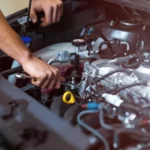It’s been a year since I got my Tesla Model 3. Time really does fly when you’re having fun behind the wheel of this beauty. As the anniversary of purchasing my Tesla approached, I started thinking about maintenance. What kind of scheduled maintenance does a Tesla even need? That’s what I’m going to breakdown in this ultimate guide.

Content
Tire Rotations and Replacements
Just like a gas-powered car, tires need to be rotated and eventually replaced on a Tesla. I’ve found that my tires typically last around 50,000 miles before needing to be replaced. Be sure to get your tires rotated every 6,000-10,000 miles to help them wear evenly. One time I put off a rotation too long and noticed abnormal wear on the inside edges – don’t be like me!
Brake Pads and Fluid Flushes
Tesla Electric Vehicle Maintenance & Repair works a little differently than what you may be used to. Since regeneration handles most of the braking, brake pads actually last much longer than a gas vehicle – around 100,000 miles. Brake fluid should also be flushed every couple years. The first time I took it in, my brake pads still had at least 30% life left in them. Regenerative braking is a game changer.
Cleaning the Air Filter
Every 24,000 miles or so, I clean out the cabin air filter which filters the air coming into the car. It’s an easy DIY maintenance item that I’ve been able to do myself in just a few minutes. One time I forgot and it really needed cleaning – allergies were hitting hard! Now I make sure to swap it out on schedule.
Battery & Drive Unit Inspections
Tesla recommends having the battery and drive unit inspected every 6 years or 150,000 miles – whichever comes first. This gives technicians a chance to inspect the overall health and performance of these major components. So far mine have been given a clean bill of health!
Over-the-Air Updates
One of the best parts about Tesla ownership is that software updates are continuously improving the car. I’ve gotten new features, performance increases, and bug fixes without even leaving my driveway. The future is now thanks to OTA updates – no more trips to the dealer!
As you can see, Tesla electric vehicle maintenance & repair is pretty low maintenance overall. Just routine fluid and filter changes with much longer lasting parts like brakes. Let me know if you have any other Tesla maintenance questions!

Tom’s blog is your passport to adventure. If you’ve got an itch for travel and a love for the road, join him in exploring new horizons. His writing is the ultimate road trip planner and companion.












